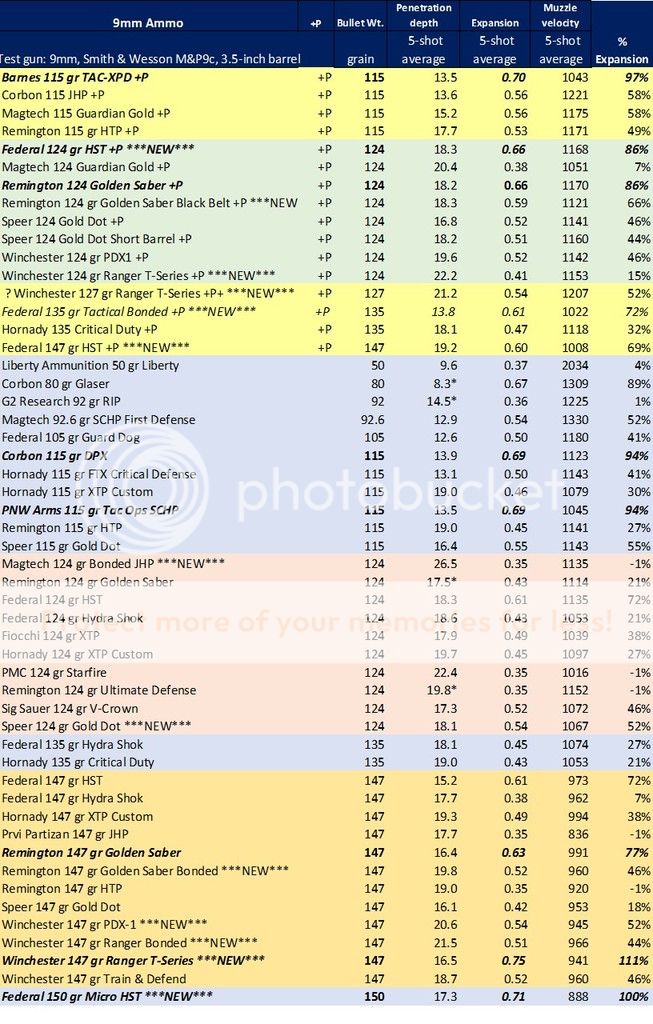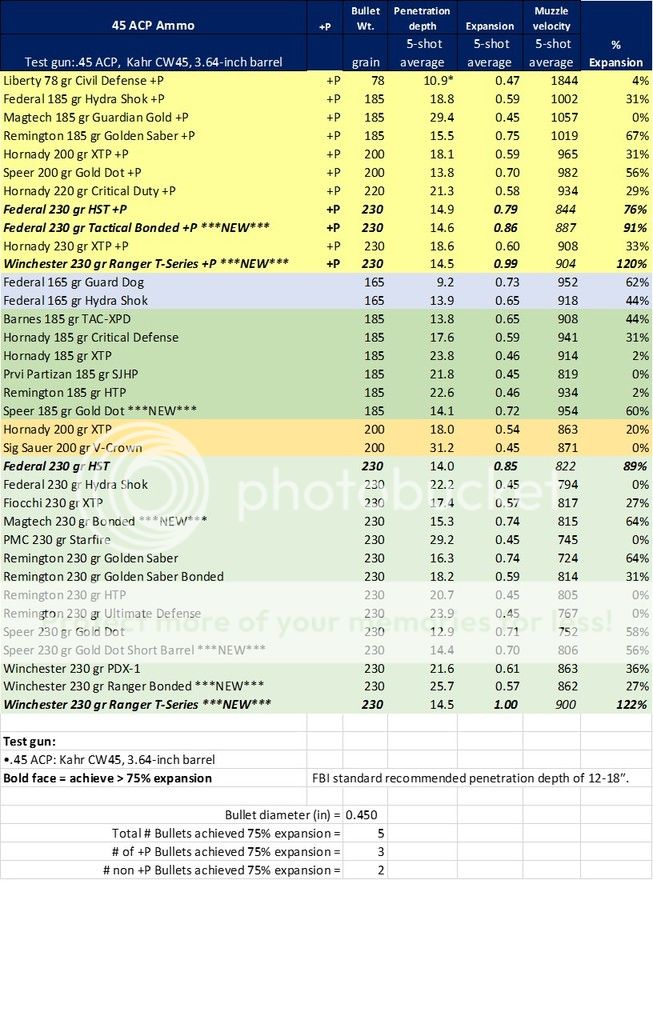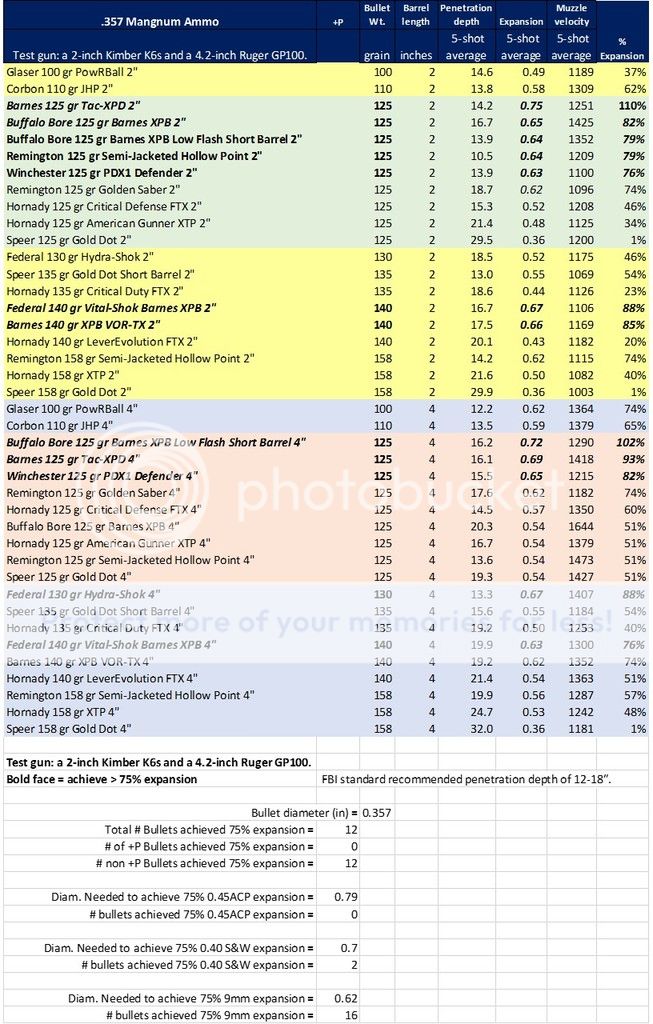I am a data geek so I could not help myself when I found the handgun test data on various ammo brands penetration & expansion by Lucky Gunner. I have "rearranged" the data format to make it more clear for me on what it means. Perhaps others on this board will find it useful for their ammo selections. I will be posting data from 5 different calibers, .38 SPCL, .357Magnum, 9mm, .40S&W, and .45ACP.
*edit* my definition of % expansion. It is the additional diameter increase as result of bullet expansion. So if its a 75% expansion, the expanded bullet diameter is 1.75X of the original diameter.
The original test data and its test methodologies can be found on this link
http://www.luckygunner.com/labs/self-defense-ammo-ballistic-tests/
Let's start with the 9mm. The gun used for testing was the Smith & Wesson M&P9c, 3.5-inch barrel. The result could vary and be more favorable if you use a longer barrel.

A little explanation is needed. I rearranged the data to sort out +P vs non-+P and by ammo weight. I also bold face the ammo that achieved 75% of its expansion from the original diameter (an arbitrary criterion on my part). Lucky Gunner stated ".. One commonly used threshold is an expanded diameter at least 1.5 times the original diameter, but that’s far from universal...". The penetration criterion Lucky Gunner chose was the FBI standard recommended penetration depth of 12-18″. Those with an * show they retained less than 85% of their original weight on average so their data were not counted.
My observation of the table:
1). Out of 52 different ammo tested, only 8 of them have expanded 75% or greater.3 of them are +P and 5 of them are non- +P
2). +P ammo did not achieve better expansion than the non +P ammo. Since penetration between 12-18" are considered adequate, they were not counted as a decision factor.
3). +P ammo did well with lighter weights, 115 and 124 gr., but not with the heavier weight such as the 147 gr.
4). Non +P ammo did well on either end of weight, 115 and 147 gr, but not in the middle, e.g., 124 gr.
5). This will probably be controversial. I consider if I carry the 9mm, what ammo would achieve the same 75% expansion diameter of a 45ACP (at 0.79 in), or of a 40S&W (at 0.7 in). I found zero 9mm ammo that can match the 45 ACP expansion, but 3 of which could match the 40S&W expansion diameter. Amazingly, one of them is at the lighter end of ammo weight, Barnes 115 gr TAC-XPD +P , and the other two are at the higher end but non +P, Remington 147 gr Golden Saber and Federal 150 gr Micro HST. But one must trade this against the benefits of higher capacity and lower recoil a 9mm brings.
Of course, this is only one test conducted by a company. It is not a definitive conclusion. Let us keep an open mind on what this means. I will update with other caliber test results. But I've found all these very interesting.
*edit* my definition of % expansion. It is the additional diameter increase as result of bullet expansion. So if its a 75% expansion, the expanded bullet diameter is 1.75X of the original diameter.
The original test data and its test methodologies can be found on this link
http://www.luckygunner.com/labs/self-defense-ammo-ballistic-tests/
Let's start with the 9mm. The gun used for testing was the Smith & Wesson M&P9c, 3.5-inch barrel. The result could vary and be more favorable if you use a longer barrel.

A little explanation is needed. I rearranged the data to sort out +P vs non-+P and by ammo weight. I also bold face the ammo that achieved 75% of its expansion from the original diameter (an arbitrary criterion on my part). Lucky Gunner stated ".. One commonly used threshold is an expanded diameter at least 1.5 times the original diameter, but that’s far from universal...". The penetration criterion Lucky Gunner chose was the FBI standard recommended penetration depth of 12-18″. Those with an * show they retained less than 85% of their original weight on average so their data were not counted.
My observation of the table:
1). Out of 52 different ammo tested, only 8 of them have expanded 75% or greater.3 of them are +P and 5 of them are non- +P
2). +P ammo did not achieve better expansion than the non +P ammo. Since penetration between 12-18" are considered adequate, they were not counted as a decision factor.
3). +P ammo did well with lighter weights, 115 and 124 gr., but not with the heavier weight such as the 147 gr.
4). Non +P ammo did well on either end of weight, 115 and 147 gr, but not in the middle, e.g., 124 gr.
5). This will probably be controversial. I consider if I carry the 9mm, what ammo would achieve the same 75% expansion diameter of a 45ACP (at 0.79 in), or of a 40S&W (at 0.7 in). I found zero 9mm ammo that can match the 45 ACP expansion, but 3 of which could match the 40S&W expansion diameter. Amazingly, one of them is at the lighter end of ammo weight, Barnes 115 gr TAC-XPD +P , and the other two are at the higher end but non +P, Remington 147 gr Golden Saber and Federal 150 gr Micro HST. But one must trade this against the benefits of higher capacity and lower recoil a 9mm brings.
Of course, this is only one test conducted by a company. It is not a definitive conclusion. Let us keep an open mind on what this means. I will update with other caliber test results. But I've found all these very interesting.
Last edited:






